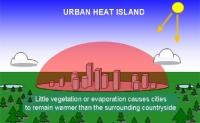Group studies the Caribbean climate
Submitted on 3 September 2006 - 3:36pm
This article is reproduced by CienciaPR with permission from the original source.

By Idem Osorio
iosorio@uprm.edu
Prensa RUM
The activity, celebrated August 4th, counted on the participation of doctor Jorge González, main investigator of the NASA-EPSCOR (Experimental Program to Stimulate Competitive Research) program of the Sciences and Engineering Resource Center of the RUM, who had in charge the initial presentation and emphasized the contribution that these projects make to understand the climatic changes in the region.
González, who summarized his findings on the effect of the use of the land in the climate, was part of the research team in the project of undergraduate student Dorianne Alvarado, whose work was centered in the impact of urbanism in the climate of Puerto Rico.
After analyzing the temperatures of the urban and rural zones of the Country between the months of January to March, as well as the precipitation in a period of 40 years, Alvarado concluded - among other findings- that the use of land in the urban zones has increased the local temperatures because of the heat absorbed by structures and the pavement.
According to the coordinator of the Caribbean Climatic Studies project, Pieter Van der Meer, this scientific research has great relevance because they foment the prediction capacity.
The group integrated by 10 undergraduate students and 5 graduate students also studied subjects related to climate in the Caribbean region, such as the concentration and distribution of aerosols in the atmosphere analyzing data coming from the Observatory of Arecibo and satellites; the concentration of sediment materials in the water of the bay of Mayagüez; and the effect of the increase of cloudiness in the change of temperature in the region, among others.







